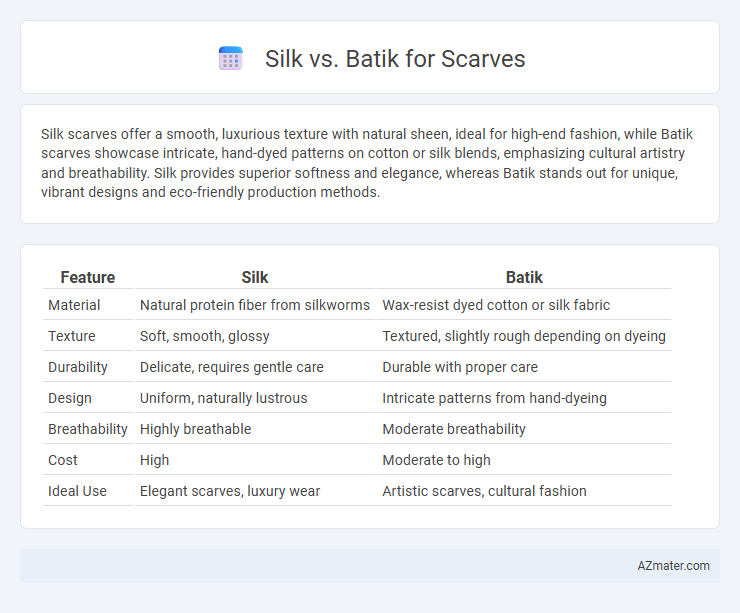Silk scarves offer a smooth, luxurious texture with natural sheen, ideal for high-end fashion, while Batik scarves showcase intricate, hand-dyed patterns on cotton or silk blends, emphasizing cultural artistry and breathability. Silk provides superior softness and elegance, whereas Batik stands out for unique, vibrant designs and eco-friendly production methods.
Table of Comparison
| Feature | Silk | Batik |
|---|---|---|
| Material | Natural protein fiber from silkworms | Wax-resist dyed cotton or silk fabric |
| Texture | Soft, smooth, glossy | Textured, slightly rough depending on dyeing |
| Durability | Delicate, requires gentle care | Durable with proper care |
| Design | Uniform, naturally lustrous | Intricate patterns from hand-dyeing |
| Breathability | Highly breathable | Moderate breathability |
| Cost | High | Moderate to high |
| Ideal Use | Elegant scarves, luxury wear | Artistic scarves, cultural fashion |
Introduction to Silk and Batik Scarves
Silk scarves are prized for their luxurious texture, vibrant sheen, and smooth drape, making them a timeless accessory in fashion. Batik scarves showcase intricate wax-resist dyeing techniques originating from Indonesia, featuring unique patterns and vivid colors that highlight artisanal craftsmanship. Choosing between silk and batik scarves involves considering fabric softness, design complexity, and cultural significance for a stylish and meaningful wardrobe addition.
Origins and Cultural Significance
Silk scarves, originating from ancient China, have been prized for their luxurious texture and status symbol across Asian and European cultures. Batik, a traditional technique with roots in Indonesia and Malaysia, involves wax-resist dyeing that produces intricate, symbolic patterns representing cultural narratives and local heritage. Both silk and batik scarves embody rich artistic traditions, reflecting the distinct cultural identities and craftsmanship of their regions.
Material Composition: Silk vs Batik
Silk scarves are made from natural protein fibers produced by silkworms, known for their smooth texture, lightweight feel, and luxurious sheen. Batik scarves feature fabric, often cotton or silk, decorated through a wax-resist dyeing technique, resulting in intricate patterns with vibrant colors. The material composition of silk offers superior softness and breathability, while batik combines traditional artistry with various fabric bases, impacting durability and texture.
Weaving vs Dyeing Techniques
Silk scarves showcase intricate weaving techniques that create a smooth, lustrous fabric with natural sheen and strength. Batik scarves highlight the wax-resist dyeing process, where patterns are hand-drawn with wax before multiple dye baths, resulting in vibrant, culturally rich designs. Weaving in silk emphasizes texture and fiber quality, while batik focuses on color artistry and detailed motifs achieved through skilled dye application.
Visual Appeal and Design Patterns
Silk scarves offer a luxurious sheen and smooth texture that enhances vibrant colors and intricate, detailed design patterns, making them highly prized for elegant, high-fashion looks. Batik scarves showcase unique, hand-dyed motifs with characteristic crackled texture and earthy tones, reflecting artisanal craftsmanship and cultural heritage from regions like Indonesia and Malaysia. While silk emphasizes luminous brilliance and fluid drape, batik stands out through its distinct organic patterns and rich symbolic meanings embedded in each design.
Texture and Comfort Level
Silk scarves offer a smooth, luxurious texture that feels incredibly soft against the skin, providing excellent comfort due to the natural fiber's breathability and lightweight properties. Batik scarves, often made from cotton or a cotton blend, feature a slightly coarser texture with a unique tactile pattern from the wax-resist dyeing process, resulting in a more textured but still comfortable wearing experience. The choice between silk and batik for scarves depends on the preference for either a sleek, cool feel or a more artisanal, textured comfort.
Durability and Maintenance
Silk scarves offer luxurious softness and vibrant colors but require delicate care, including hand washing and avoiding exposure to sunlight to maintain their durability. Batik scarves, crafted from cotton or silk with wax-resist dyeing, tend to be more durable and easier to maintain, often withstand machine washing and regular use without significant color fading. Choosing between silk and batik depends on balancing the need for durability with the willingness to commit to specific maintenance routines.
Sustainability and Ethical Considerations
Silk scarves, made from natural protein fibers produced by silkworms, offer biodegradability but face concerns regarding animal welfare and intensive resource use in sericulture. Batik scarves, typically crafted from cotton or silk with wax-resist dyeing techniques, emphasize traditional artisan methods promoting cultural preservation and local economies, often supporting sustainable handcraft practices. Evaluating sustainability involves considering silk's environmental footprint versus batik's support for ethical craftsmanship and renewable materials in textile production.
Price Comparison and Accessibility
Silk scarves tend to be more expensive due to the high cost of raw silk and labor-intensive production, often ranging from $50 to several hundred dollars depending on quality and brand. Batik scarves, which are typically made from cotton or rayon, offer more affordable options generally priced between $20 and $70, making them accessible to a wider range of consumers. Accessibility also varies geographically, with silk scarves widely available in luxury boutiques and online retailers, while batik scarves are often found in specialty artisan markets and culturally specific regions such as Indonesia and Malaysia.
Choosing the Right Scarf for Your Style
Silk scarves offer a smooth, luxurious feel and vibrant sheen, ideal for formal or elegant styles, while batik scarves provide unique, hand-dyed patterns reflecting cultural artistry, perfect for bohemian or casual looks. Consider the occasion and your wardrobe's color palette; silk complements sleek silhouettes and evening wear, whereas batik adds artistic flair to everyday outfits. Selecting between silk and batik depends on balancing texture, pattern, and personal style preferences to enhance your overall appearance.

Infographic: Silk vs Batik for Scarf
 azmater.com
azmater.com